#Downward Spirals
Text

Mahesh Magar, a guide with Himalayan Research Expeditions, exits a cave on the Khumbu Glacier, just a short walk from Everest Base Camp. With elevations of more than 17,500 feet above sea level, these are some of the highest mapped caves in the world. Caves like this one are forming in high altitude Himalayan glaciers as soaring temperatures send more meltwater cascading through the insides of glaciers, melting tunnels that are literally rotting glaciers from the inside out.
These Caves Mean Death For Himalayan Glaciers
Otherworldly Ice Caves are Rotting the Glaciers From the Inside Out, Putting Villages Below in the Path of Devastating Potential Flash Floods.
— By Douglas Fox | Photographs By Jason Gulley | January 10, 2024
Jason Gulley has spent 19 years crawling through the insides of glaciers, from Alaska to Nepal. Sometimes these caves, carved through the ice by running water, are large enough for a truck to drive through. Other times, they’re so narrow that he slides along the slippery floor on his belly. If he pauses, his clothing can freeze to the ice.
Gulley is a geologist at the University of South Florida, who began his career studying limestone caverns. It was only by chance that he started exploring the insides of glaciers. The first time he entered one of these caves in the Mount Everest Region, on Lhotse Glacier, was a harrowing experience.
He and his companion stood outside the entrance, watching basketball-sized rocks rain down from the unstable ice cliff overhead. After gathering his wits, he sprinted inside—followed a moment later by Douglas Benn, a veteran Himalayan Glaciologist from the University of St. Andrews in Scotland.
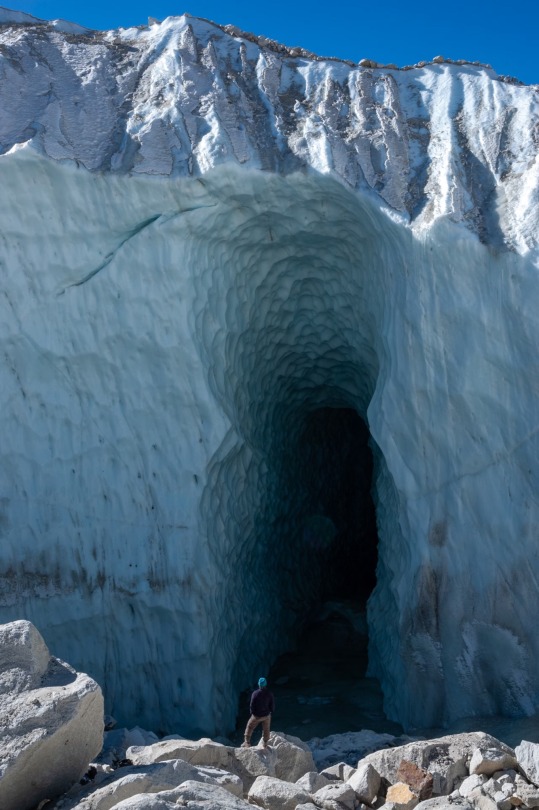
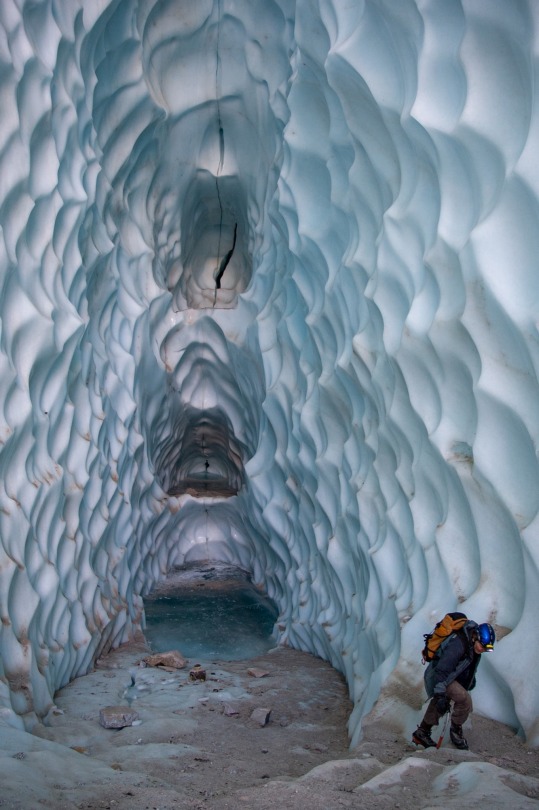
Left: Glaciologist Doug Benn enters a massive cave on the Khumbu Glacier in December 2006. This cave formed as ponds of melted water, sitting on top of glaciers, elevated water pressured and punched open the cracks, causing lake water to surge into the surrounding ice. Right: As the mountainous region warms, these ponds of melted water are becoming more common, hastening the demise of frozen glaciers.
After a few minutes in the cave, they accidentally triggered a minor collapse. The brittle ceiling shattered in a rain of ice shards. “That’s when it really started to dawn on us,” says Gulley. “We really have no idea of what could kill us in here.”
In the years since, Gulley, Benn, and several other scientists have managed to explore these little-known caves. Their work has laid bare the private lives of glaciers—and the disease that is rapidly consuming them.
Glaciers in the Himalaya are thinning by up to nine feet per year, and these caves are playing a pivotal role, hollowing out and collapsing the ice from within.
“It’s the cancer that’s eating what’s left of the glacier,” says Gulley.
As the world warms, the tongues of these glaciers are melting into large lakes, which threaten to unleash flash floods upon villages in the valleys below.
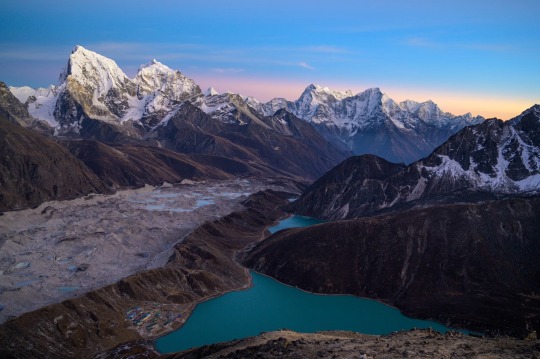
The Sherpa settlement of Gokyo lies beneath the rapidly disappearing Ngozumpa Glacier. Like nearly half of the glaciers in Nepal's Everest Region, the Ngozumpa Glacier is covered in rocky debris shed by adjacent mountains.
Little-explored Caves
Glaciers in the Himalaya differ from what most people imagine. Stand at the lower end of Ngozumpa Glacier, which flows from 26,864-foot Cho Oyu, the world’s sixth-highest mountain, and you will see what appears to be a jumble of rocks filling the valley.
Ngozumpa, like many Himalayan glaciers, is fed by avalanches that sweep down from above—depositing snow, rocks, and boulders onto its upper reaches.
As the glacier descends into warmer air, its surface starts to melt. This removes the upper layers of ice, bringing the buried rubble back to surface. There it accumulates in a layer, up to four feet thick, covering the glacier.
Many Himalayan glaciers are “debris-covered,” like Ngozumpa, and scientists believed that this would insulate them from warming temperatures. But it hasn’t worked out that way, says Teiji Watanabe, a geomorphologist at Hokkaido University in Japan, who has frequently visited the Everest Region since the late 1980s.
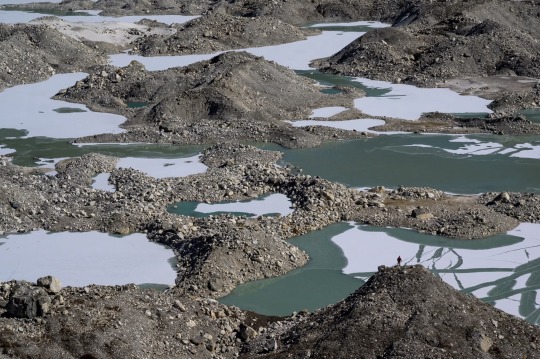
Melting water forms pools on the debris-covered Ngozumpa Glacier, in the Everest region of Nepal. Lakes like these heat up during summer and provide large sources of relatively warm water that can carve cave passages into the ice by melting the layers of ice below.
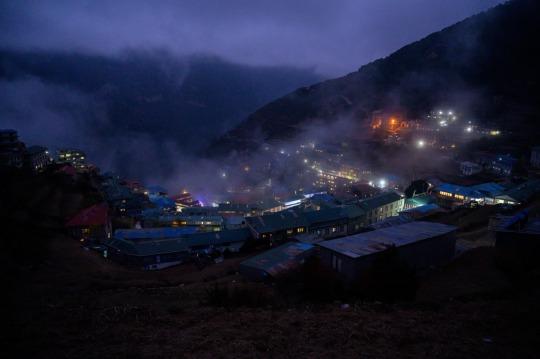
Electric lights in the Sherpa capitol of Namche Bazaar light up the night sky. Namche Bazaar and other nearby Sherpa settlements receive electricity from a small hydroelectric power plant. Infrastructure like this is vulnerable to floods from overlowing glacier lakes.
In the past few decades, the surface of Ngozumpa and other debris-covered glaciers has become pocked with thousands of sinkholes up to 100 feet deep, as the ice shrinks beneath the rocks. Melt ponds frequently fill these depressions. The total area of these ponds has tripled in 30 years—a rate of change that “is really, really amazing,” says Watanabe.
The cause of that rapid change was a mystery. But around the year 2000 Benn, the Scottish glaciologist, noticed a clue.
Melt ponds on Ngozumpa and other debris-covered glaciers often disappeared overnight. At the bottom of these empty depressions, Benn found cave openings, through which the lake had drained.
No one knew how extensive those caves were, or where they went.
But in 2004, Benn met Gulley—an accomplished caver—through a mutual friend.
Benn’s photos of gaping cave openings and pitted glaciers reminded Gulley of limestone landscapes in the Caribbean, where thousands of sinkholes had formed as caves collapsed beneath the surface. With Gulley’s expertise, they entered their first glacier cave in the Everest Region, in 2005.
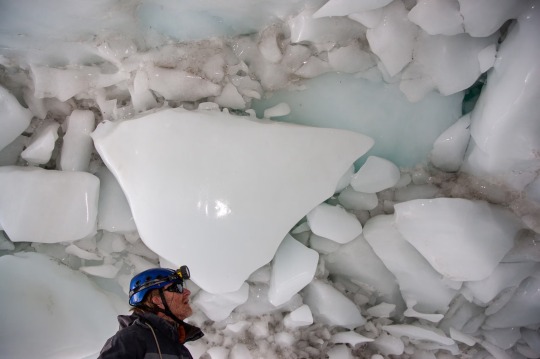
Glaciologist Doug Benn examines the roof of a glacier cave on Nepal's Khumbu Glacier. The entire cave roof consists of blocks of shattered ice that had been frozen together.
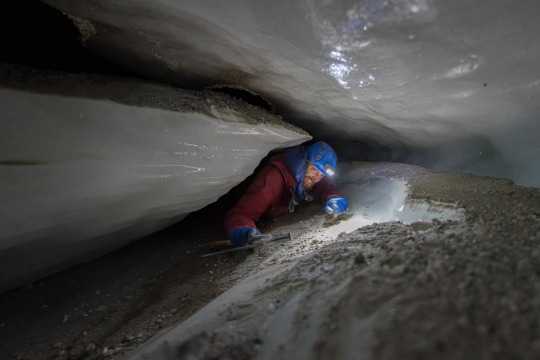
Glacier researcher Matt Covington moves through a tight section of a cave inside the Ngozumpa Glacier, during a 2018 expedition. Crawling at altitudes between 15,000 and 18,000 feet above sea level is one of the most physically demanding parts of cave exploration.
A Downward Spiral of Melting Caves
As they ventured into the darkness, the beams from their headlamps illuminated the fog of their breath. Thin layers of dust, as fine as flour, coated the surfaces — “as if the cave was a store that went out of business 30 years ago,” says Gulley.
They hurried out of that first cave after part of its ceiling collapsed.
Their second cave entry, several days later, didn’t go much better. As they walked down a passage, their spiked crampons crackling on the ice, Gulley suddenly plunged through the floor.
Only later did they realize they’d been walking on a false floor—a veneer of ice, three quarters of an inch thick, that had formed on top of standing water. That water later drained out from below—leaving the five-foot void that Gulley fell into.
They gradually learned to avoid these hazards. And as they explored Ngozumpa Glacier, year after year, Gulley was amazed at how these meandering ice caves resembled limestone caverns—except in the glacier, the ornate scallops, grooves, stalagmites, and stalactites had formed in a few months, rather than thousands of years.
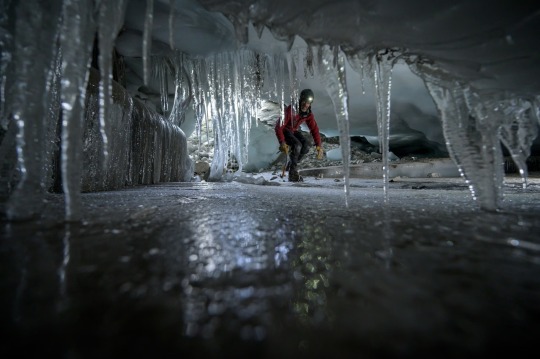
Jason Gulley navigates a cave in Nepal's Ngozumpa Glacier, stooping as he walks. Even experienced cave explorers struggle to descend caves covered in ice.
The caves formed where bands of debris-rich ice provided a weak spot that melt water exploited. The passages were often round, with a deep chasm cutting into the floor, indicating it was carved by gushing water that eventually slowed to a stream.
But glacier caves also differed in some striking ways.
As Gulley and Benn made repeated trips to Ngozumpa Glacier, they saw that narrow passages often squeezed shut from one year to the next—the glacial ice oozing inward like silly putty. Those passages melted open again the next time water from a draining lake gushed through.
These observations led Benn and Gulley to a theory—published in 2017—of how caves erode debris-covered glaciers.
“As those caves expand and collapse, they’re creating new depressions, that create new lakes, that create new caves,” says Gulley.
As this downward spiral continues, the depressions expand and deepen, forming ice cliffs that melt quickly because they’re warmed by sunlight. Warm melt ponds undercut the ice cliffs—crumbling them—exposing more bare ice.
In this way, a depression “can grow faster and faster the bigger it gets,” says Ryan Strickland, a PhD student studying caves at the University of Arkansas.
Strickland used a drone to measure 3,000 depressions on Ngozumpa Glacier. His analysis, published in August, suggests that depressions really do grow more quickly as they expand—consistent with Gulley’s theory that melt caves drive the process.
“It’s absolutely plausible,” says Owen King, a mountain glaciologist at Newcastle University in the United Kingdom, who has worked in this region. “The mechanisms that Ryan has described, we can definitely see evidence for.”
The melt water gushing through caves gathers in a massive lake near the glacier’s terminus. Spillway Lake is half a mile long. It is dammed by a massive ridge of rubble that the glacier piled up over thousands of years. As it grows, it could rupture that dam, sending several million cubic yards of water plunging down the valley.
In 1985, a glacial lake outburst flood eight miles southwest of Ngozumpa swept away 14 bridges, 30 houses, and a hydroelectric plant. This flood risk will increase as more glaciers give way to lakes.

Mere steps from Everest Base Camp, a pair of researchers drop into a glacier cave on Nepal's Khumbu glacier. Rising temperatures and melting ice lowered the ice surface at Everest Base Camp by a staggering 98 feet between 1984 and 2015.
A Remnant Cave Left High and Dry
When Gulley visited Ngozumpa Glacier in 2018 and 2019, he was shocked by what he saw. Very few caves remained. So much of the glacier had sagged down to the level of Spillway Lake, that melt water was no longer driven to flow downhill and create new caves.
They did find one fragment of a cave that Gulley first mapped in 2005. Back then its entrance was at the bottom of a depression. But now all that remained was a short section of cave piercing a ridge of ice.
Even as melt caves disappear from the lower reaches of Ngozumpa, they will penetrate higher up the glacier’s 22-mile length. Melt caves will eviscerate more and more glaciers—creating lakes that could release devastating floods.
“These caves are symptoms of dying glaciers,” says Gulley. “This is what almost all of the glaciers in the Everest Region are going to be turning into.”
1 note
·
View note
Text
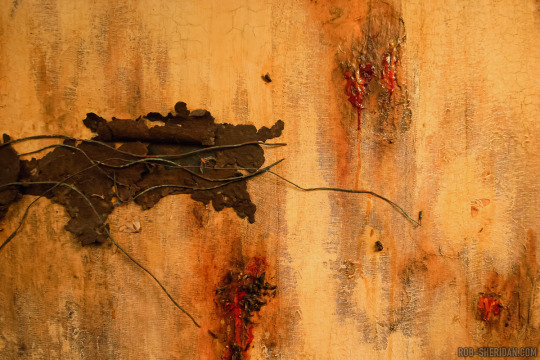
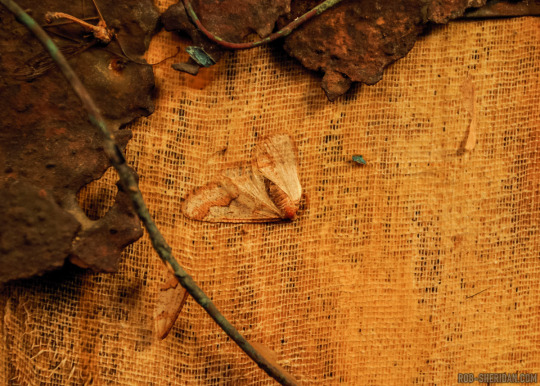
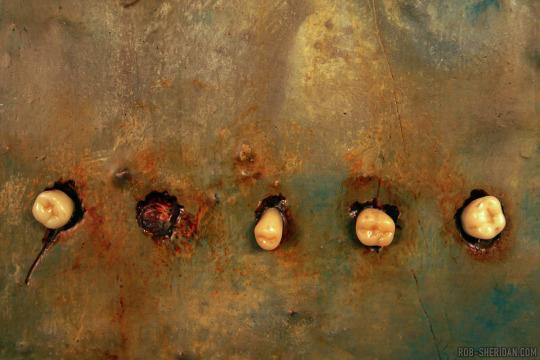

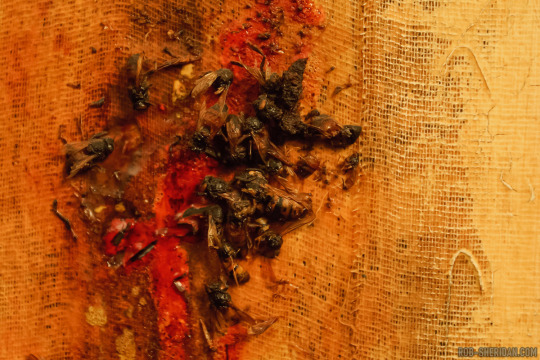
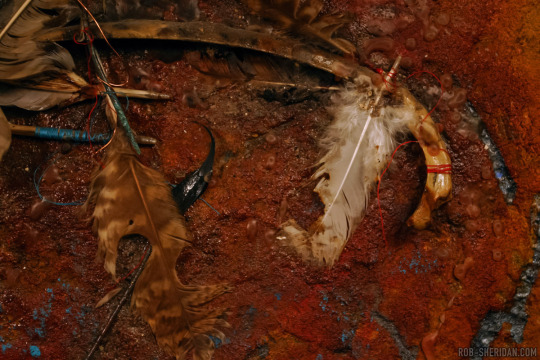
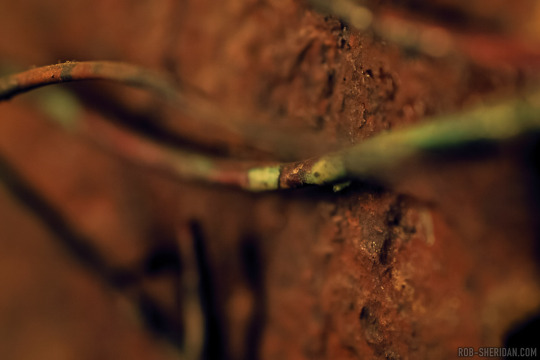



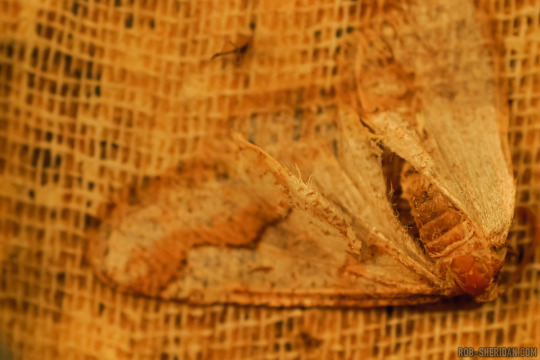
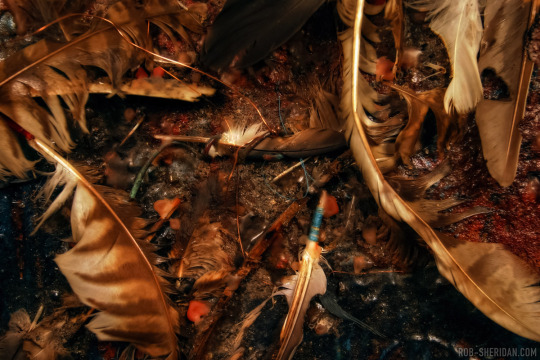
Hard to believe Nine Inch Nails' classic The Downward Spiral is 30 years old today! Here is some detail photography I took of the original album cover painting by Russell Mills for the 10th anniversary deluxe edition release, which I had the unique honor of designing, and somehow that is now 20 year old.
Everyone has that one album that hit at just the right moment of adolescence to change their perspective on music and get them through their teenage angst. The Downward Spiral was that album for me, released as it was in 1994, when I was a freshman in high school (and an absolute banner year for music/films/games all around). I must have stared at the artwork for hours over those years, without even much detail to draw from on its tiny 5” CD slip case. So five years later, when I found myself inexplicably working for Nine Inch Nails, it was surreal to see the actual original painting in the flesh, hanging as it was at the time in Trent Reznor’s office at Nothing Studios, New Orleans.
I was struck by how much dimension and texture there was in the artwork that never translated on that tiny slipcase printing, how much detail was happening in the physical materials of the art: Flies, moths, wires, blood… I had been staring at this “painting” for so long, yet suddenly it was like I had never seen it before. I also noticed that it had aged - the wires had wilted over the years, drooping down from their original position as captured in the original album cover (interestingly, judging by the photo posted today by NIN, the piece has since been restored); a tooth was missing from the other main piece.
That experience stuck with me and it was the first thing I thought about when the task of re-imagining the album package fell upon me in 2004. I wanted to re-photograph the artwork, subtly updating the cover to show that ten years had changed it physically, much like our perceptions of art and music and memories change over time with perspective. I also wanted to dig into the previously unseen details of the work and explore it with my macro lens, so that fans like me, old and new, could have new layers of texture to pore over for hours while listening to a legendary album.
Happy birthday, old friend.
#nine inch nails#the downward spiral#nin#trent reznor#90s nostalgia#90s music#industrial#rob sheridan#Russell mills#photography#album art#album design
2K notes
·
View notes
Text

Same old same old
#If you stare at the abyss for too long it’s stares back at you#badboyhalo fanart#bbh#qsmp fanart#badboyhalo#c!badboyhalo#eggpire#At your wits end#doomed to repeat the same downward spiral to madness#though vaguely different#and it’s like you’re looking at a mirror of what you once were.#Qsmp
2K notes
·
View notes
Text

1K notes
·
View notes
Text

Trent Reznor with Russell Mills' "Wound", March 8th, 2024
611 notes
·
View notes
Text

watching the world burn
#cw blood#tw blood#he looks so good when he’s in his downward spiral sorry#jjk geto#geto suguru#suguru geto#jujutsu geto#jjk#jujutsu kaisen#jjk 0#arctvros
1K notes
·
View notes
Text









THIRTEEN
2003, dir. Catherine Hardwicke
#thirteen#thirteen 2003#thirteenedit#filmedit#movieedit#fyeahmovies#filmreel#doyouevenfilm#filmgifs#2000s#self harm tw#drugs tw#y2k#gifs*#evan rachel wood#nikki reed#catherine hardwicke#idk who to tag in this sry#this film had a lot of impact on me bc it came out when I was about 13 and tbh 13-year-olds had no business watching this#the directing choices make the setting of tracy's downward spiral disturbing and its super good unfortunately#it makes sense that catherine hardwicke did this film and twilight she loves a crusty cool toned filter and nikki reed
477 notes
·
View notes
Text

RE4 Leon my dearly beloved…
#I am just so fascinated by this man’s downward spiral.#I would drop everything for him even my first born#I think he would benefit from a nice back massage#or something better#(gets shot)#thinking about my Leon Kennedy birthday cake in 2019. you were beautiful#leon Kennedy#resident evil 4#RE4 Leon Kennedy
509 notes
·
View notes
Photo

Further Down The Spiral (1995)
#old magazines#90s#music#nin#coil#aphex twin#rick rubin#nine inch nails#nothing records#trent reznor#russell mills#the downward spiral#1995#hologram parade#robin finck#danny lohner#chris vrenna#charlie clouser#dave navarro#new musical express#further down the spiral
775 notes
·
View notes
Text

cool bug fact spyke and the album 'the downward spiral' by nine inch nails are the same age
#teethdraws#the downward spiral is his album ong#splatoon#splatoon art#splatoon 3#splatoon fanart#splatoon fandom#spyke#splatoon spyke#spyke splatoon
473 notes
·
View notes
Text

(x)
#u#web finds#nine inch nails#nin#tech#ipod#music#the downward spiral#trent reznor#alternative#2000s#00s
542 notes
·
View notes
Text
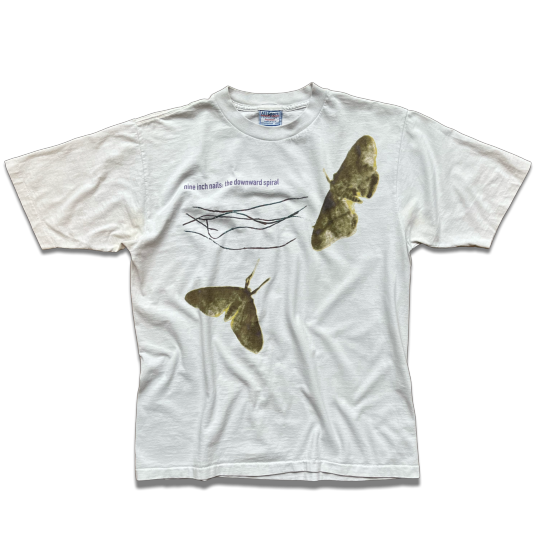

Nine Inch Nails
2K notes
·
View notes
Text


NIN
#want so bad#need#nine inch nails#nin#merch#fashion#the downward spiral#eraser#transparent#my edit#up#1k
2K notes
·
View notes
Text
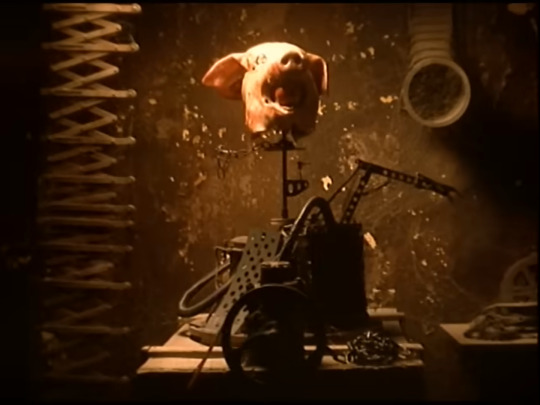



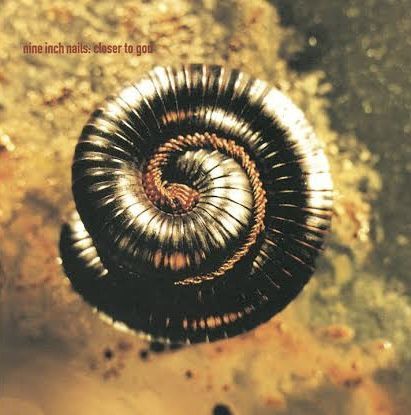



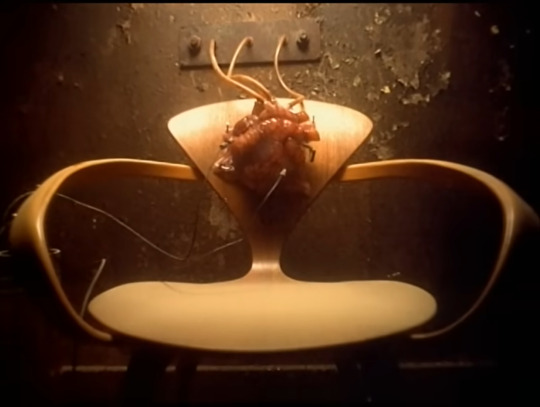




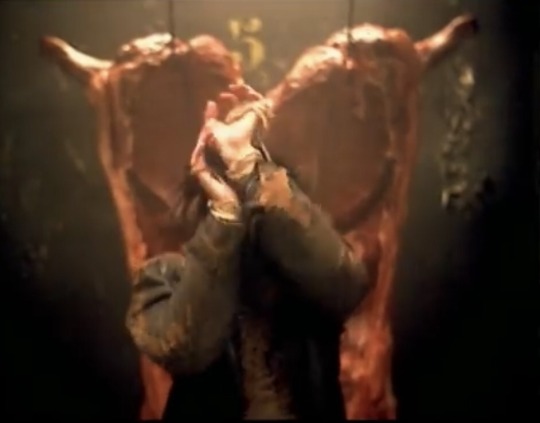





816 notes
·
View notes
Text
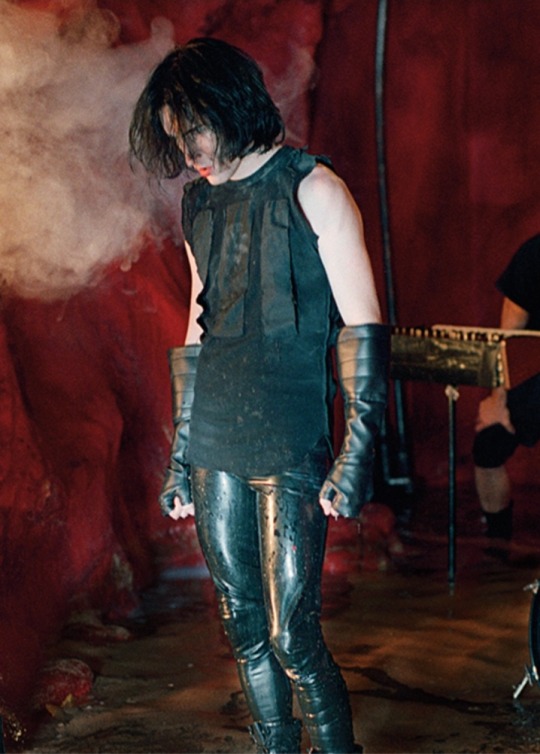

#trentreznor#trent reznor#danny lohner#james woolley#robin finck#nineinchnails#nine inch nails#the downward spiral#march of the pigs#tds era#joseph cultice
599 notes
·
View notes
Text
I feel like people understand that Dick changed while Jason was gone, but where it goes wrong half the time is people assume that Dick "growing up" meant that Dick was irresponsible around the time he and Jason interacted/was mean and unable to conceal his jealousy well, which he then evolved from due to Jason's death and was able to build a loving big brother relationship with Tim and Damian and fix his relationship with Bruce.
Meanwhile canon is like:
>Be me, Dick Grayson, esteemed and respected leader of the Teen Titans
> Your younger brother dies
> Fire the youngest member of the Titans because it happened because you had a crisis of responsibility about child vigilantism
> Get punched by your not-official dad
> Help mentor new younger brother because you can't stop him and Bruce from the path they're on, and like hell is another kid going to die
> Kid dies. Not that one. The ex-member of the Titans died disobeying your orders and saving the world in a heroic sacrifice you didn't want him to make, this is exactly what you tried to avoid
> So did two of your friends and one of their moms
> Failed marriage, and a whole lot of relationship stuff you don't want to talk about
> Dad didn't ask you to surpass him in the roll he trained you for since you were 8, gives it to a guy who goes of the rails and starts trying to kill ppl
> Dad asks you to take the roll because he literally has 0 other options and wants to take a vacation
> Bond with younger brother II more, will kill everyone in this room and yourself if anything happens to him
> Move to a new awful city that's often compared to hell
> Having nothing to lose makes it kind of nice here
> Younger brother II gets killed by the same guy who killed younger brother I
> Kill the guy
> Younger brother II wasn't actually dead
> Dad used CPR, so neither is the guy who killed them
> Angst over not being a good enough person not to kill your brother's murderer
> Things start to become okay again
> Best friend dies
> Get shot in the shoulder and fired from your job
> Childhood home gets burned down, 20+ people die
> Apartment building blows up, 22 of your friends and acquaintances die
> Find out it's because someone was specifically targeting you
> Person dies for talking to you
> Choose to step aside and let the guy targetting you die
> Run home because dad needs help
> Get shot in the leg, while passed out another kid hero dies
> Quit being a hero
> Join the mob
> Things start to get better
> Help dad out with some case about this guy named the Red Hood
> City gets nuked because you live there
> Get radiation burns and pass out while saving people, content that you died doing something good
> Dad saved you
> You're still alive :/
> Propose to your ex-girlfriend (not the one from the last marriage)
> Crisis event happens, take a laser beam meant for your father
> Coma for 3 weeks
> She says no (for good reasons)
> You're still alive :/
~and around here is where Dick finds out Jason's alive~
Anyways Dick was not more well adjusted by the time Jason came back from the dead, his life was a constant series of L's, and he got worse 😎
#anyways aus where Jason comes back and is like wtf is wrong with you? >>>> aus where Jason is like. wow dick sucked ass as a brother to me#how come he's so well adjusted and loving to the rest of you#dick did change while jason was gone. he did not get better. he only got worse#Dick's downward spiral of a life is everything to me#most ppl also forget that it took time for Dick and Damian to get along he was not doing good at first shdjdjjdjd#and tim was off doing his own thing for a while at the time#dick grayson
2K notes
·
View notes